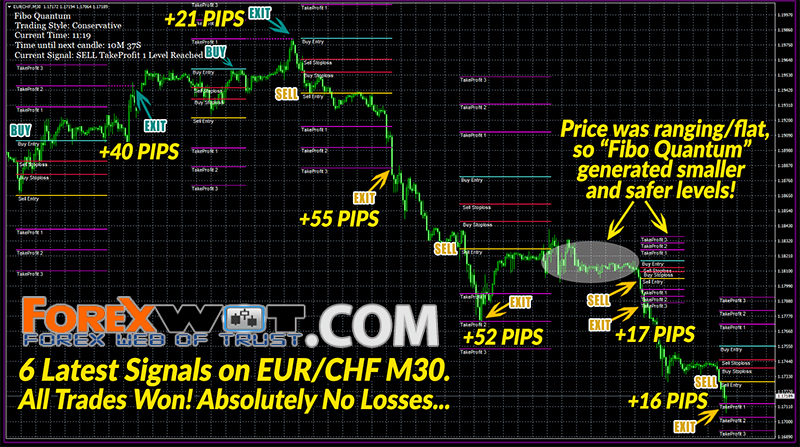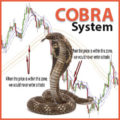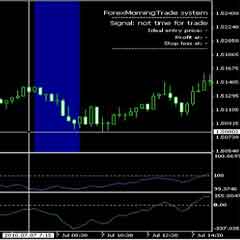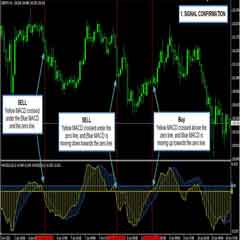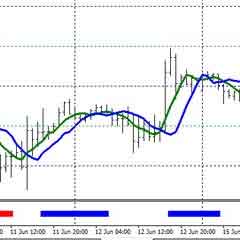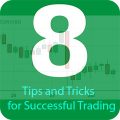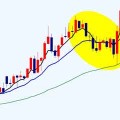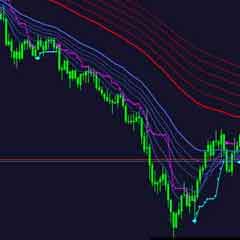ForexScanner System Description: Complete Guide To Forex Trading, The best and safest trades are made in the main direction of the trend. Once the trend is identified the next step is timing.
When is it time to enter the market?
In bullish markets, trades need to be executed on dips. In bearish markets, trades need to be executed on rallies.
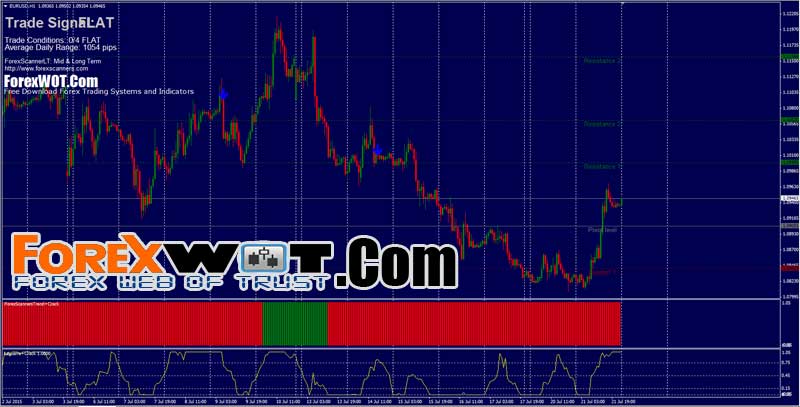
This system uses proprietary indicators to identify trend direction and then uses ForexScannerST or ForexScannerLT in order to isolate trading opportunities to buy dips in a bullish market or to sell rallies in a bearish market.
- ForexScannerST Indicator: Programmed for 5 min forex trading.
- ForexScannerLT Indicator: Programmed for 1 hour, daily and weekly trading.
ForexScanner system can be used for short, medium and long term forex trading. Whether you are a scalper, daytrader, swing trader or long term forex trader, you will always find a timeframe(s) that fit your needs.
ForexScannersTrend Indicator Description: This indicator uses logic to detect trend direction and reversals at an early stage. A green color bar implies the market is trending upwards while a red color bar implies a downward trend.
After you’ve finished the installation procedure, you can start the MetaTrader 4 Client from your desktop or from the Start menu via MT4’s shortcut.
If the MT4 Client was running while you installed the ForexScanner package, you have to restart MT4 (exit and re-start it again), otherwise you won’t be able to use the ForexScanner System.
Now, click on the File menu at the top-left corner > select the Profiles option > finally select the ForexScanner5Min profile.
You will see how 9 charts pop up in your MT4 platform screen:
EURUSD, USDCHF, GBPUSD, USDJPY, USDCAD, NZDUSD, EURJPY, GBPJPY and AUDUSD.
We recommend you to re-adjust them to fit your screen by clicking on the Window menu, and selecting the Tile Vertically option.
Re-load the profile to make sure all arrows appear on your charts. Congratulations. You’re done!
Welcome to the ForexScanner System!
Your MT4 screen should look like the picture below:
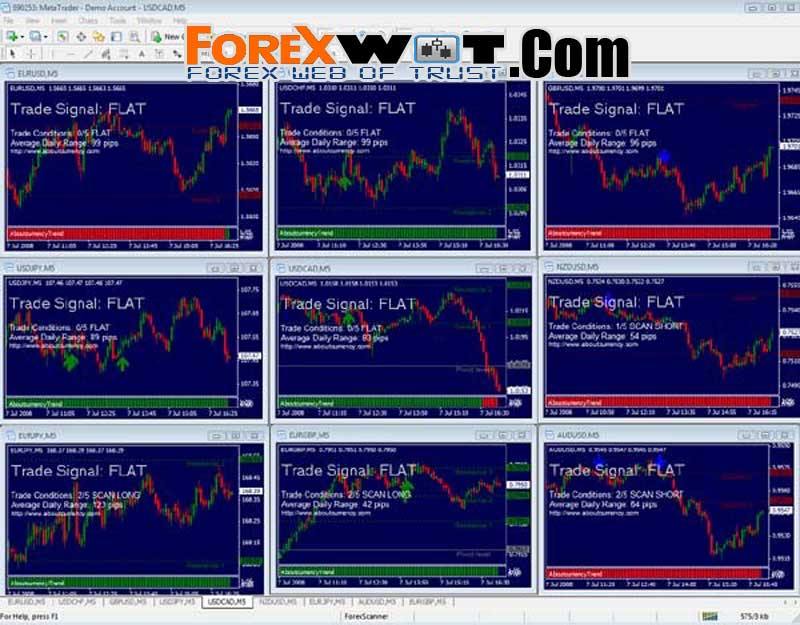
Okay, you’re ready to investigate the system itself…
There are three core indicators we”ll be concerned with: the ForexScannerST indicator, the ForexScannerLT indicator and the ForexScannersTrend indicator. Below you can have a look what the indicators actually look like when applied on your MT4 charts.
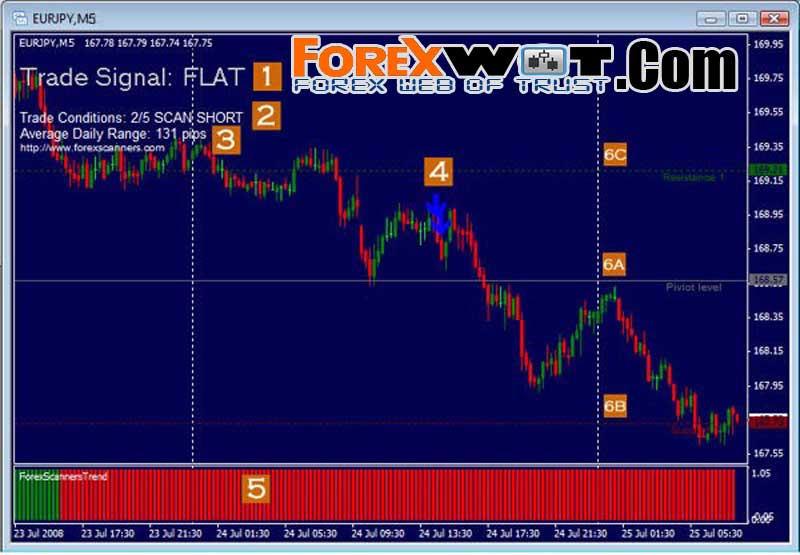
The ForexScannerST indicator and ForexScannerLT indicator are almost identical. We will be using the ForexScannerST indicator to trade 5 min charts and the ForexScannerLT indicator to trade 1 hour, daily and weekly charts.
Now let us debrief you on what each point means exactly:
1. ForexScanner Alert:
Generates buy and sell alerts in real time when a new signal is available for trading – three possibilities:
- Trade Signal: FLAT (no signal)
- Trade Signal: BUY (buy signal)
- Trade Signal: SELL (sell signal)
When the market moves to the next bar, the BUY or SELL alert will usually disappear and return to FLAT value. A pop box will also appear on your MT4 screen.
2. ForexScanner Trade Conditions:
Displays current trade conditions.
A. ForexScannerST Indicator
- 0/5 FLAT (no market trend)
- x/5 Scan LONG (forexscannerST searches for long signals)
- x/5 Scan SHORT (forexscannerST searches for short signals)
Note: number between 1 and 5, if x = 5 then ForexScannerST will send out a new trading alert and an arrow will appear on the chart.
B. ForexScannerLT Indicator
- 0/4 FLAT (no market trend)
- x/4 Scan LONG (forexscannerLT searches for long signals)
- x/4 Scan SHORT (forexscannerLT searches for short signals)
Note: number between 1 and 4, if x = 4 then ForexScannerLT will send out a new trading alert and an arrow will appear on the chart.
3. Average Daily Range:
Displays the average daily range (daily high – daily low) in pips for any currency pair measured over a 10-day period.
4. ForexScannerST and ForexScannerLT Indicator Buy and Sell arrows:
These arrows appear on the charts in real time.
Two possibilities:
- Green Arrows (buy signal)
- Blue Arrows (sell signal)
Both ForexScanner indicators (ST and LT) place historical trading buy and sell arrows on your charts, up to 8000 bars and exactly where they would have occurred in real time, so it will be easy for you to review them.
5. ForexScannersTrend Indicator:
Identifies a change in trend direction and then print a green bar below the main chart if the current trend bias is bullish or a red bar if the current trend bias is bearish.
The indicator is a unique one in terms that it’s based on past AND current price action which means that it takes the past 1-3 months as a sample, and then adapts for current market conditions.
6a 6b 6c:
Pivot point and support/resistance levels displayed on the charts. These levels are automatically updated every day. Some traders use them for entry and/or exit strategies. For your reference only.*
*We don’t use this feature in our ForexScanner system trading approach.
As you can see, reading the ForexScanner system indicators is both easy and intuitive. Once you’ve gone through it a few times, it will take you only a moment to recognize whether there are any trading opportunities on a given day.
How do we enter ForexScannerST/LT indicator buy and sell signals?
The picture below shows a buy signal (green arrow) which appears at the close of candle
- We buy immediately at the open of candle
- It’s that simple! We use the same approach for sell signals (blue arrows will appear on the chart).
Metatrader 4 platform will notify you in three ways when a ForexScannerST/LT trading opportunity is identified:
- A pop-up box appears showing ForexScannerST/LT is long or short.
- An arrow will appear on the chart (Blue for SELL, Green for BUY).
- Trade Signal (chart left upper corner) will display: SELL or BUY for 1 or 2 candlesticks periods. Then it will return to “FLAT”.
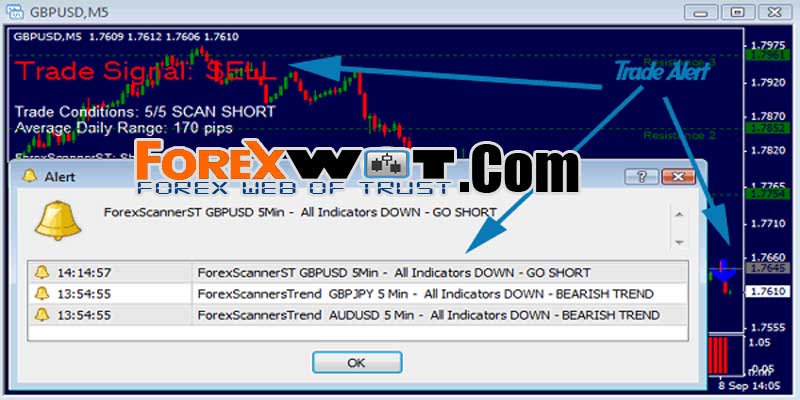
The picture above shows the ForexScanner indicator pop up box, trade signal “Sell” and the blue down arrow for a sell signal generated on the GBPUSD 5 min chart.
A stop loss ensures that a particular position is automatically closed at a predetermined price in order to limit potential losses should the market move against the currency trader’s position. Stop losses are crucial in order to avoid unnecessary large losses.
There are many different ways to set steps. If you find a method that works for you, then stick to that method. However, one of the recommendations we make is to set all of your stops based on the marketplace.
They usually corresponds to support “Swing Low” and resistance levels “Swing High” in the market. It is very important when forex traders set stops not to just arbitrarily say, when they enter a trade,”If the market goes against me by 50 pips, I am going to get out.”
Our preferred method of using the currency pair’s price action to determine risk is to use the low of the most recent swing low or consolidation period as our stop point when buying or to use the high of the most recent swing high or consolidation period as our stop when selling. It is recommended to place your stop 3 pips above / below the most recent swing high / swing low.
The picture below shows how to place your stop. In this case above the most recent swing high. (because we are selling).
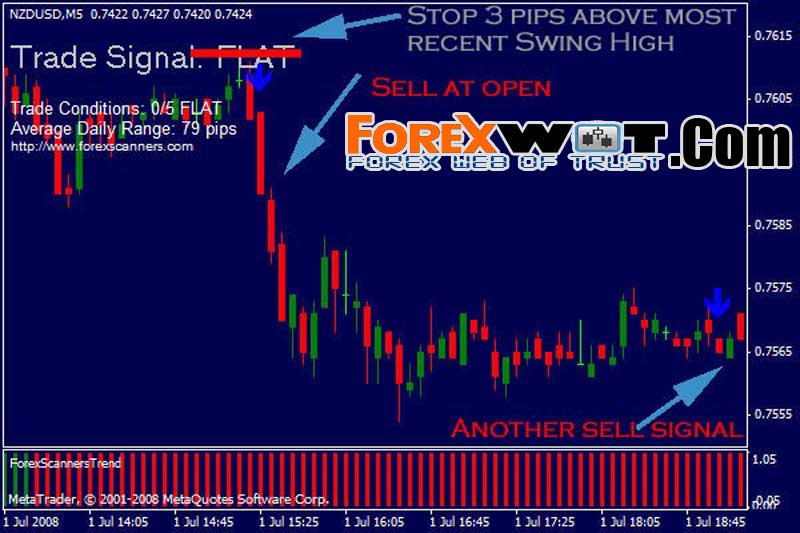
Question: Shall I take more buy or sell arrows pointing in the same direction within the same trading day?
Answer: We personally do not trade any additional arrows pointing in the same direction while we’re already in the trade because we don’t want to over leverage our trading account.
ForexScanner typical stop losses used for each timeframe:
Depends upon the volatility of the currency pair traded and the most recent swing high or swing low:
- 5 min chart : 15-35 pips
- 1 hour chart : 35-85 pips
- daily chart : 125-350 pips
- weekly chart : 250-400 pips
Question: What if I have to place my stop to far away from the entry point, for example 60 pips on the 5 min chart?
Answer: Best is to skip this signal and to wait for smaller downside risk trading opportunities.
When To Exit A Trade?
Four possibilities:
- If your initial stop-loss has been hit.
- If your trailing stop has been hit.
- If a buy or sell arrow appears in the opposite direction.
- If the trade hit your profit target level.
Setting profit targets allows us to close a profitable trade at the point where we’re satisfied with the profits we’ve already made.
We can take profits in many different ways, for example using pivot points, Fibonacci, SAR points,.. below you will find our 3 preferred profit taking strategies.
This approach is very easy to understand. The risk-to-reward is the ratio between the potential gain and the potential loss.
Let’s say a trader buys the EURUSD currency pair at 1.5600 and places a stop loss order at 1.5570, total risk will be 30 pips. Let’s also assume that this trader believes that the price of the EURUSD will reach 1.5660 in the next few hours.
In this case, the trader is willing to risk 30 pips to make an expected return of 60 pips after closing the position.
Since the trader stands to make double the pips that he has risked, he would be said to have a 2:1 risk/reward ratio on that particular trade.
Important: As a general rule, move your stop to break even (entry level) once your are up 75% of your target level.
For example, your target is 100 pips, move your stop to your entry point as soon as the trade moves 75 pips in your favor. This rule does not apply for target levels below 40 pips or when using trailing stops!
An example:
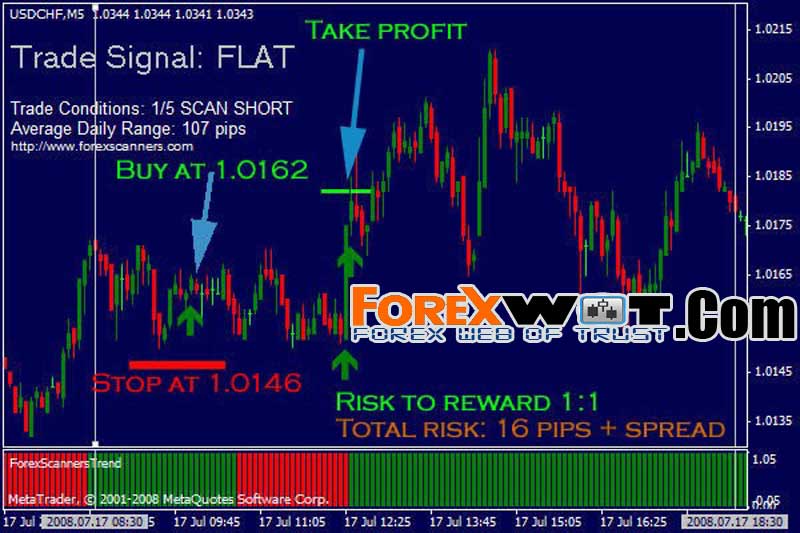
A ForexScannerST buy arrow appears on the above chart and we buy at 1,0162. Our stop loss is set 3 pips below the most recent swing low at 1,0146.
Total risk is 16 pips + spread (let’s assume 3 pips). When applying a risk-to-reward ratio 1:1, our profit taking level needs to be set at 1,0162 + 16 pips + 3 pips = 1,0181.
Our target was hit about 3 hours later.
We don’t move our initial stop to entry (break even) because our profit target is only 19 pips.
Trailing stops will eliminate the guess work associated with, when to exit the currency pair even though it has hit your predicted target level. This way you can let your profits run until these stops get violated.
Basically, a trailing stop loss involves the moving of your stop-lossbelow or above swing levels as your trade progresses in your favor. Another way in trailing stops is to set a fixed pip amount to trail the market price. This can be done on autopilot in most forex trading platforms.
If for example the trailing stop loss is set to trail the market by 40 pips and your stop is initially placed below the entry price by 40 pips, and as the market price moves up by 40 pips, the new stop loss is shifted to the entry price.
Question: Which trailing stop loss approach is best?
Answer: We like to trail our stop 3 pips below previous swing lows for long trades or 3 pips above previous swing highs for short trades.
This is our preferred approach when it comes to exit strategies. It involves the buying or selling of 2 positions, and to exit the first position at a predefined level using risk-to-reward ratio’s, and to trail the second position below previous swing lows or above previous swing highs until our trailing stop gets violated.
An example:
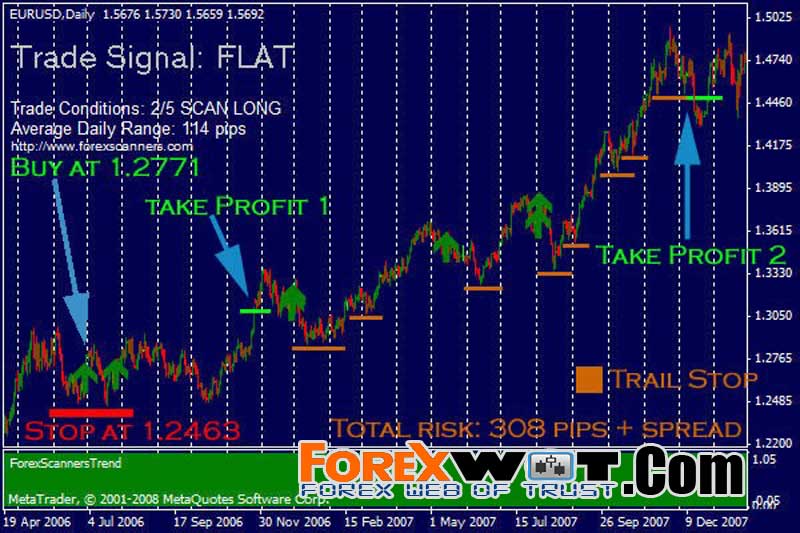
A ForexScannerLT indicator buy arrow appears on the EURUSD daily chart and we buy 2 lots EURUSD at 1,2771.
Our initial stop is 3 pips below the most recent swing low at 1,2463. Total risk is 308 pips + spread (let’s assume 2 pips) =310 pips.
First lot (Take Profit1):
In this case, we apply a risk-to-reward ratio 1:1. Our profit taking level needs to be set at 1,2771 + 308 pips + spread = 1,3081.
Our profit target was easily hit at 1,3081 for 310 pips.
This creates a risk-free trade for the second lot! Total pips achieved so far: + 310 pips, total pips at risk: 310 pips Please note: we will move our stop for the first lot to break even once we achieve 75% of our profit taking level. This is 310 pips x 75%=232 pips.
Second lot (Take Profit2):
We trail our stop 3 pips below the most recent swing low as shown on the picture above. We get stopped out at 1,4491 for 1718 pips! This target was hit about 18 month later.
It is recommended to re-enter trades in the same direction of the current trend only once during the same trading day or trading session.
Have a closer look at he picture below for a clear example of reentering trades in the same direction.
You’ve originally bought the EURUSD pair at 1,5783 and as the trade continues, you are stopped out at your initial stop 1,5766.
What to do now?
Wait for the next signal to appear (if any) and re-enter the trade as shown in the picture above. You need to re-define your stop-loss level to 3 pips below the most recent swing low.
What shall be done if this trade is a failure?
Stop trading this currency pair/this timeframe in the up direction (green arrows) for the trading session or wait for a reversal signal (now trading blue arrows).
If this trade is a failure again then stop trading this currency pair for the rest of the day. Worst case scenario is 3 stops within 1 trading day or trading session (5 min charts).
Please note that the above situation will very rarely happen but we like to give you all possibilities that might occur.
We ignore all ForexScannerST & LT indicator signals one hour prior to important news events. After the news is being released, wait 15 min to take any new signals.
Why not to trade these events?
- The market can take out your stop very easily by whipping back and forth.
- Some brokers do not honor stops during important news events which can cause a far larger than anticipated loss.
It is important to know about the date and time the news are due, to be able to prepare to possible short-term extreme market conditions.
Question: What if I am in a trade prior to the news event?
Answer: Move your stop-loss to entry if the trade is profitable, or just keep your stop to the initial stop-loss point.
So which is better?
There’s no right or wrong answer to that question. It depends entirely on how much risk you’re willing to take as a currency trader.
When Are Economic News Releases Issued?…
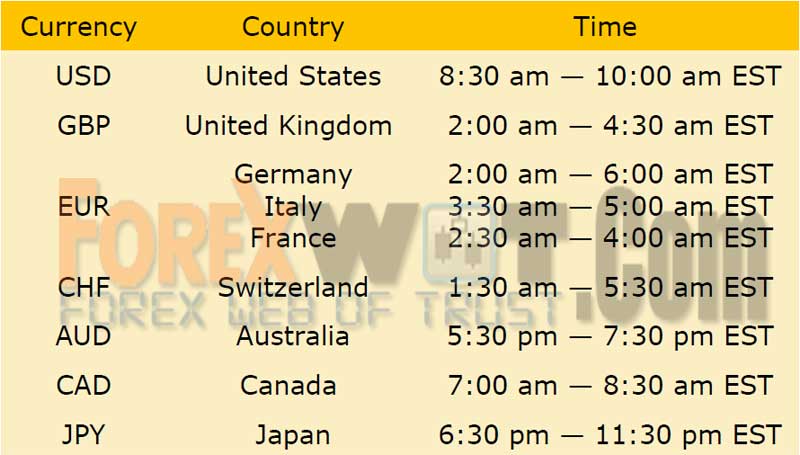
What Are the Key News Releases?
The Daily FX calendar bolds the important releases and also lists the “consensus” figures. Generally speaking, these are the most important economic releases for any country:
- Interest rate decision
- Retail sales
- Inflation (consumer price or producer price)
- Unemployment
- Industrial production
- Business sentiment surveys
- Consumer confidence surveys
- Trade balance
- Manufacturing sector surveys
One of the most important skills a forex trader has to develop is money management. It is as important as taking entries or exits. Without money management it is very difficult for a trader to be successful. Whether you are a scalper, daytrader, swing trader or long term trader, it just doesn’t matter. You need to manage your money properly.
Without money management, one could have two or three losses in a row, and if you don’t have have a strategy in place to manage your money, those losses could be so large that you have to stop forex trading or you may be so emotionally discouraged that you give up.
If you have money management in place, though, it is limiting your exposure or risk on each trade, and you can easily handle five or six losses because you are within the risk-of-ruin guidelines and your draw down is not severe.
Trading the ForexScanner system; when you get ready to enter a trade, you know where your initial stop -loss is going to be – Three pips below the most recent swing low when going long or three pips above the most recent swing high when going short.
So if you know your entry level, and you know where your stop is, then you can calculate your trade size which is, your position size to keep your risk in line.
As a general rule, never risk more than 2% on any give trade or a 6% total portfolio risk at any given time. And total risk should be spread out over different currency pairs. Let’s assume you have total trading account of $20,000. How do yo manage your risk on any given trade?
According to the above rule: Never risk more than 2% of your account on any one trade. Calculating lot size…
An example:
Account Size: $20,000
Account Type: Mini
Currency Pair: EURUSD
Trade Direction: Long
Max. Risk: 2%
Value of one pip on the EURUSD ($/Pip): $1
Entry: 1,5500
Initial Stop: 1,5470
Pips at risk: 30
Max. Risk – all open positions: ($20,000 /100) *2= $1200
Max. risk – EUR/USD trade: ($20,000 /100) *2= $400
Calculating Lot size – EUR/USD trade:
$400/30 pips= $13,33/pip (Max. Risk / Pips at Risk)
1 mini lot EURUSD = $1/pip
($13,33/pip)/($1/pip)= 13 mini lots
If you have a $20,000 mini account, the maximum lot size you can trade without exceeding 2% risk of your account balance on this trade is 13 mini lots.
Question: What if I want to trade 6 different currency pairs at any given time?
Answer: Never risk more than 6 % of your account in total. So, we recommend in this case to risk 1% each on your 6 open positions. Make sure to never exceed 6% of your total account size, even when you trade 18 currency pairs.
Question: A nice trade pop up but I have already 6% at risk. What shall I do?
Answer: Two possibilities here 1. Skip the trade, 2. Close a trade and open the new trade.

